Canoe Sufferfest 2024: Nethy Bridge to Berwick-Upon-Tweed
One of the many things I love about Scottish paddling is that when something gets promoted as a ‘first’, it regularly turns out that somebody else did it 20 years ago and just didn’t tell anyone.
Whether it’s river boats, sea kayaks, or open canoes, a load of the big trips were done in the era of foam roll mats and headtorches with big rectangular batteries; sometimes even in the age of wooden boats, tweed jackets and pipes!
Really it doesn’t matter a lot. Like the water flowing past you, every single trip is a ‘first’. The people, the weather, the environment you paddle through are different every time.
Like all the best ideas, this one was stolen. I believe Ray Goodwin and Graham Rowe did a trip from Loch Hope to Perth back in the 1990s, which Duncan Ellis did as an epic solo trip back in 2011.
I’d looked at Duncan’s blog and wondered if there was any way to portage across the Pentlands to extend his route into the Tweed system, all the way to Berwick.
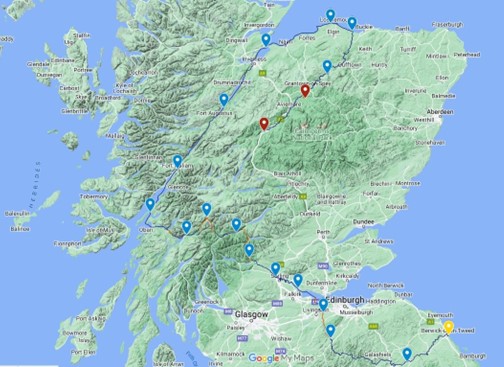
I love paddling alone, but this felt like a trip for a small team. Stephen McCall and I had done a silly Scottish trip back in March 2022. I knew he’d be up for another esoteric expedition if we could make our calendars align. As we sat chatting about Scottish trips at the English Canoe Symposium, Liam Green said something along the lines of, “I love how we’ve got a group of expedition canoeists who are basically competing to see who can have the most horrible time”. Thus, the third member of the team was found!
As our departure date loomed the weather forecast stayed set on strong SE’ly winds. Exactly what we didn’t need for the first week of our trip. The thought of slogging our way along Loch Shin into a Force 6 headwind and arriving at Dornoch to find the seas running too high to paddle on to Inverness, did not appeal. After a bit of frantic WhatsApp-ing, we changed our plan to start on the Spey. We all live close to the river, so could all start from home. As I’m the furthest downstream I ought to have had a lie-in, but as I’d only got back from Norway the previous day I was up early, frantically packing for the trip. As I left home to trolley the 100m to the River Nethy a wheel came off my trolley; I hoped it wasn’t an omen of things to come!
Week 1
An uneventful afternoon on the Spey brought us to camp at Cragganmore, just as the sun set. We reached Spey Bay the following morning. The waves looked pretty big, but it’s always hard to judge from the beach. I can confirm that they were indeed pretty big – probably the biggest surf I’ve ever paddled an open canoe through. Once I’d made it out back, beyond the breakers and signaled to Stephen and Liam to come and join me, they wisely elected to stay put. That left me with the unenviable task of coming back to shore. It all went surprisingly well at first; I managed to dodge the biggest breakers and land between the concrete tank traps. Relieved, I stepped onto the pebbly storm beach just as the next big set arrived. In the ensuing explosion of kit I got knocked over by my canoe at least twice, lost my favourite hat and spare drinks bottle (permanently), and my spare paddle and general joie de vivre (temporarily).
All-in-all a poor decision on my part, that could have punished me a lot more than it did. We decided to spend the night camped next to the surf shack on the beach at Kingston and made plans to cancel the trip if the sea state hadn’t dropped by morning.
After a restless night’s sleep, we woke to sea conditions that were just the right side of wrong. We sailed along towards Lossiemouth, temporarily losing sight of the tops of each other’s sails in the biggest of the swells. Approaching Lossie, nobody fancied picking our way between the waves breaking over the Covesea Skerries. Instead, we snuck into the harbour, trying to time our approach between the waves and setting our angles to avoid the tidal drift across the harbour entrance. Many thanks to the harbourmasters who saw our approach; they were both supportive and helpful despite being surprised to see our open canoes out in conditions that they said some of their fishing boats wouldn’t have gone out in.
We stopped early in Lossiemouth, had the first of many fried breakfasts (this one in the harbour cafe) and spent a lazy afternoon snoozing on West Beach.
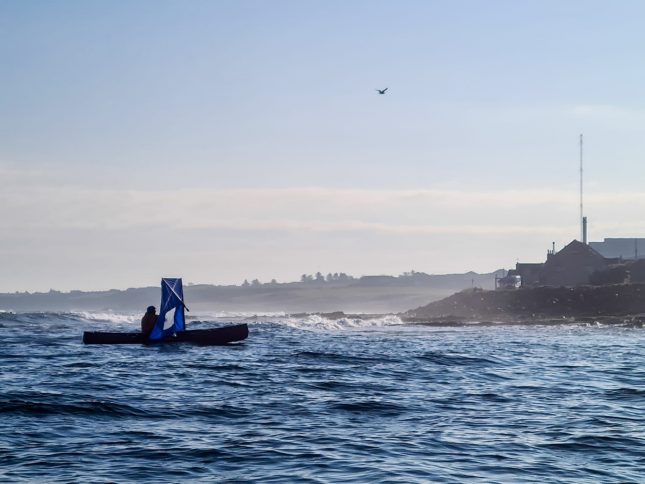
The next day fair winds and following seas took us all the way to Chanonry Point. We phoned the range to see if we could sneak through on the south side, but no such luck. Various flares, pops and crackles from Fort George confirmed that they were indeed firing into the evening. We finished the last few miles after sunset – I had my belay jacket and storm cag on over the top of my buoyancy aid, but still got off the water shivering.
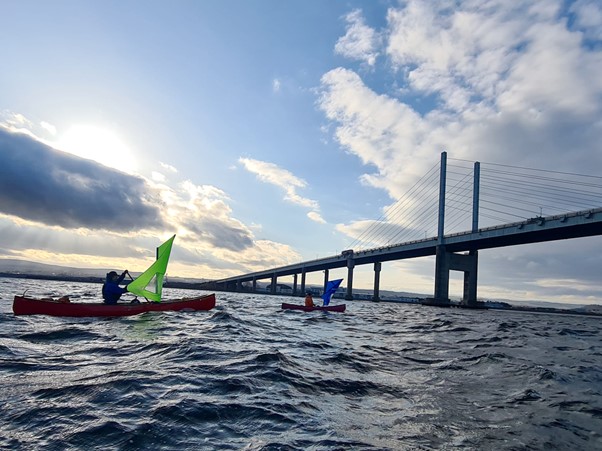
With both wind and tide with us we fairly flew underneath the Kessock bridge, and Stephen found a neat way onto the Caledonian Canal, which probably saved us a good hour of faff. We stopped for the traditional fried breakfast at the Jammy Piece and then set off along the Great Glen with sails going up and down in a light wind which kept shifting direction.
Day 6 saw us journey from close to Invermoriston over to Fort William. In strong winds on Loch Lochy, my mast foot, which had stayed happily attached for at least a decade, decided to part company from the bottom of my canoe. My bodged repair lasted all of 30 seconds. Liam’s sail ripped in the same gusts. We paddled down the bottom of the River Lochy in gathering gloom, and made our arrival into the Fort in the dark. Stephen’s partner Rosie arrived bearing a new mast foot (thank you Rosie) and Jonny Hawkins joined us with wine. Over an indecent number of burgers Stephen and Liam steered me away from a plan to portage from Loch Etive over into Loch Tulla. It helped that Jonny had done this very portage and described it as “a bit emotional”. I’ve portaged with Jonny before in the Himalaya and know that he has a terminator-like ability to deal with suffering, so it was an easy group decision to change our route.
The next day, strong offshore winds in Loch Leven saw us having to thrash our way up the loch before crossing, to avoid a surprise trip to Ardgour. I was missing my sail as we had some excellent cross wind sailing conditions. An attempt to sail as a raft with Stephen worked surprisingly well, but my plastic gunwales were gradually destroying his beautiful ash ones as the boats ground against each another. I’d just about improvised a downwind solo sail when we met up with Laura (one half of Sea Kayak Oban) and Eve who brought glue to fix the mast foot – thank you both. Favourable wind and tide brought us to one of the nicest camping spots of the whole trip, just around the corner from Port Appin. It was a novelty to be finishing in the light. Not only that; the following day’s tides were only going to work for us if we had a lie-in. What a great end to the first week.
Week 2
The thing about rivers is that they start in the hills and finish in the sea. So there comes a point where you need to go up and over to get into the next river system. Uphill travel is a whole art in itself. Choosing when to pole, paddle, track, trolley, drag or carry. It’s a really different way to look at the map. A brisk 20km of trolleying on a track or a quiet road is usually way easier than portaging 2km of rugged mountain or boggy moorland. Having efficient systems and being able to swap quickly between them can make hours of difference to a day’s travel.
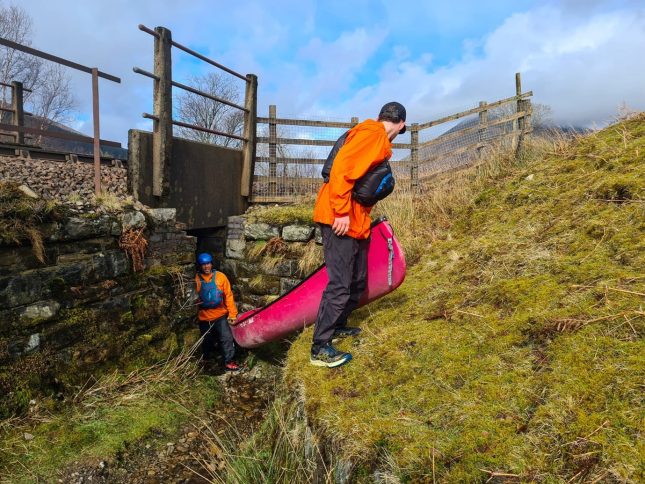
The next four days saw us travel up the Awe and Orchy, eventually reaching the Tay system at Crianlarich, then uphill again at Killin reaching the Forth system at Kingshouse. This was definitely the crux of the trip. This is one time where a sense of perspective is unhelpful. For me it’s all about putting some podcasts on the mp3 player and just concentrating on the next goal. Promising myself another drink and a piece of one of my many chocolate bars at the top of the next hill. The allegedly indestructible wheels on my trolley began to wear out, as did my feet. Liam made a great call in bringing a pair of trainers along with him for the portage – if I was doing the trip again (which at this stage I have absolutely no desire to do) – I would do the same.
Liam is nearly 30, Stephen is nearly 40 and I am nearly 50 years old. That started to show on the portages. A huge thanks to both you for your help, especially near the Awe barrage and just after of Bridge of Orchy.
Highlights include food at Bridge of Orchy Hotel, a shower at the Green Welly (probably the best £3 I have ever spent – sorry to whoever had to clean the shower after the three of us had used it), my new mast foot standing up to some hefty gusts on Loch Dochart, camping by the side of the River Fillan, catching up with Grant over in Crianlarich and a terrific breakfast at the Capercaille in Killin.
My personal nadir for the whole trip came after we’d finished the four days of (mostly) portaging. We’d pushed on into darkness the previous night and ended the day camping in a rubbish spot. It had been raining for a long time, everything was damp, and I hadn’t eaten enough. I woke up in the morning and just didn’t have any fuel left in the tank.
We portaged down the Leny, which used to be my local run. It would have provided the best white water of the whole trip (it’s a cracking grade 3-4 canoe run at the right levels), but I just didn’t feel up to it. Even a couple of hours in the pie shop in Callander failed to cheer me up or to warm me up. An early finish to the day, camping alongside the River Teith, a sunny afternoon to get all my kit dry and a 15 hour sleep did the job though! Thanks for looking after me guys 😊 The next day, feeling rejuvenated, we reached the Forth and its many, many meanders. One moment you’re heading towards the castle, half an hour later you’re pointing at the Wallace monument, twenty minutes later you have a suspiciously similar view of the castle. Eventually we escaped and started to pick up a bit of tidal flow.
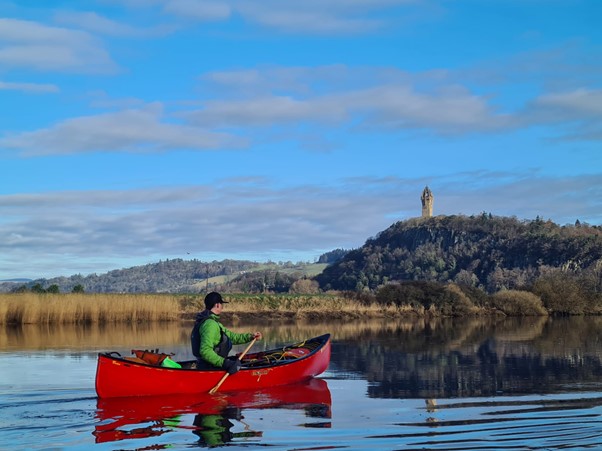
Onwards past Alloa (which Liam managed to make sound like a Hawaiian greeting) and eventually to Kincardine. A falling tide revealed some foul smelling mudflats, so we were lucky to find an old rock groyne that had been built out into the Forth. Emy kindly drove down to meet us, and after a delicious lunch at Marco’s Kitchen we said goodbye to Liam who had to leave us to go work on a sea kayak expedition. Looking onwards to the Pentland portage, we also sent Stephen’s canoe away and tried to get rid of any surplus kit. We were warned that our camping spot was where the local young team hung out, but heavy rain gave us a quiet evening.
Week 3
Stephen and I set off early to catch the tide. With two of us and all our kit in the canoe, we had noticeably less freeboard than before, but the Forth Estuary was smooth and glassy and we rode the tide, staying just north of the marked channel to stay well clear of the refinery at Grangemouth.
We landed by Blackness Castle, trolleyed onto the Union Canal and thence to the campsite at West Clifton. The two friendly women at the reception became about the twentieth people to ask which charity we were doing the trip for. They looked less surprised than most when we revealed that this was our holiday, and we just had an odd idea of what counts as “fun”. Perhaps based on the way I smelled as much as they way I looked they revealed that the campsite offered not just showers but also a bath. After a wonderful wallow and a takeaway curry, I felt as prepared as I ever could be to portage a canoe over the Pentland Hills.
We’d both worried that an unavoidable mile trolleying along the A70 might prove to be the most dangerous part of the whole trip and had wondered whether to try to time it so that we hit it late at night or early in the morning. In the end laziness won out and we left the campsite after the morning rush hour. Hats off to West Lothian council – their pavements made for great trolleying – and even on the A road people drove fairly sensibly as we jogged along the tarmac with lights fore and aft.
The old drove road – although road is perhaps too grand a word to describe it – is a well-worn boggy ditch that makes its way up to the pass between East and West Cairn Hill. In an effort to put off the inevitable moment where we had to begin carrying the boat, I continued trolleying over some rough ground. In the ensuing slow motion capsize I managed to break Stephen’s trolley.
At that point we had no option but to put the bits of trolley away and start tag teaming our kit and canoe up towards the pass. Handy yellow marker posts helped us to break up the next few hours of portaging. I’m not sure if it was having two of us that made life so much easier, if I’d got fitter or if the previous fortnight had raised the bar for suffering, but whatever the cause, the steep portage up and over was way less traumatic than I’d feared it would be. Close to the high point, we both sat in the canoe, completely blocking the path as a hiker coming the other way gave us a casual nod before carrying on past us as if nothing at all was out of the ordinary.
Past the col, the mud gradually becomes a path which spreads into a track. We managed to bodge the trolley back together using some old paraglider line from my repair kit and the piece of string that held Stephen’s sunglasses on. The repair held as we trolleyed on, and I began to think that we might actually complete the trip. Nightfall saw us back on glorious tarmac, heading into Broomlee centre. Thanks to Jamie and Richard for taking great care of us.
I don’t think the Lyne water gets paddled very often. We had perfect water levels though; any lower and we’d have been grounding out on shingle banks, any higher and we’d have struggled to avoid the many trees that had fallen across the river.
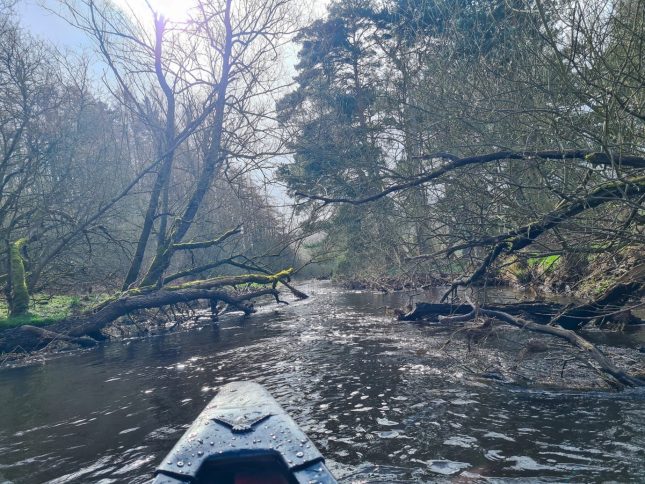
We joined the Tweed just upstream of Peebles. In contrast to the previous day’s trudge, well-groomed fishing beats and smart borders towns flew past. We spent the last night of the trip camped on a rocky island upstream of Kelso and arrived in Berwick early the following afternoon.
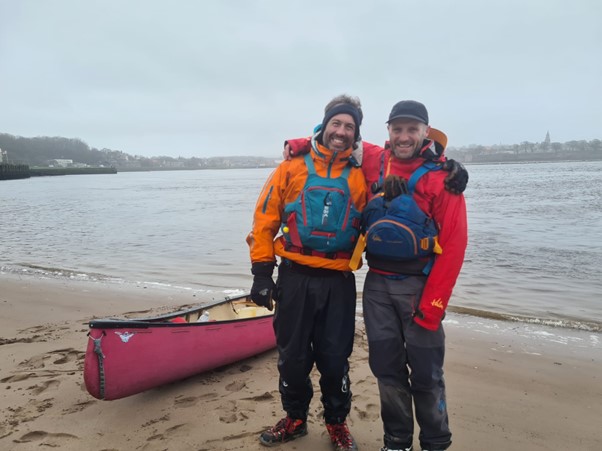
17 days, around 750km (807km for Stephen), three paddlers and loads of help from friends dotted all over Scotland. Heartfelt thanks to everyone who helped, and most of all to Stephen and Liam for being absolute legends.
The full trip from Loch Hope through to Berwick is still out there if anyone wants to do it. You never know, it might be a ‘first’! I’m tempted to do Loch Hope to Inverness at some point just to join up the lines on the map, but right now I have no desire to repeat the whole thing!
Happy adventuring.
Check out options to join us for an open canoeing skills course or adventure HERE